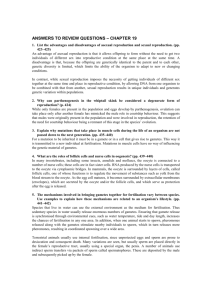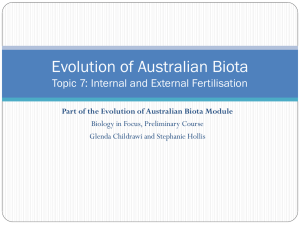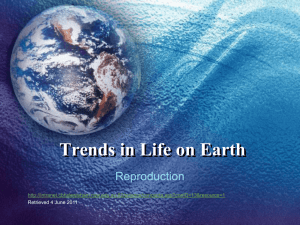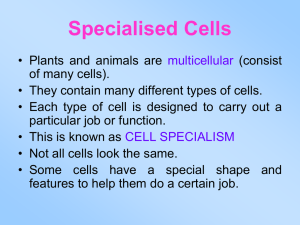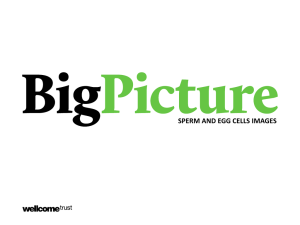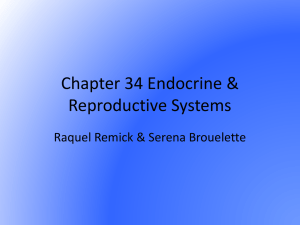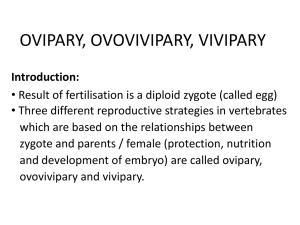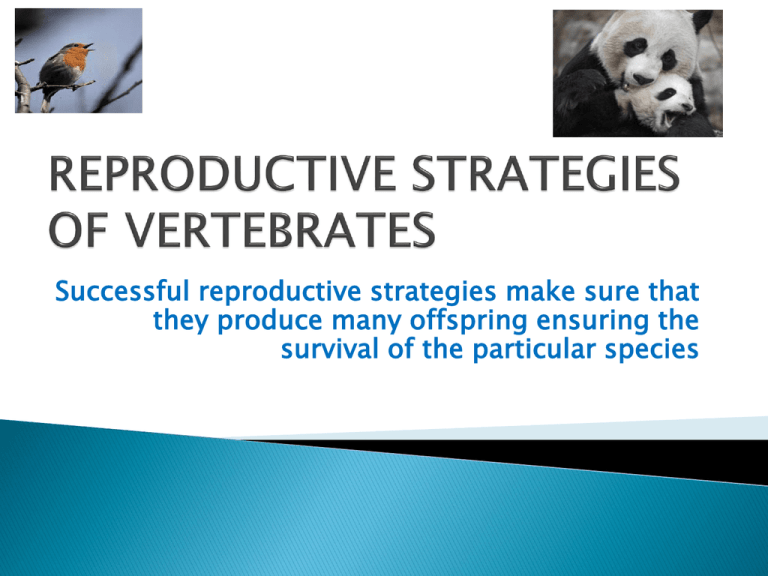
Successful reproductive strategies make sure that
they produce many offspring ensuring the
survival of the particular species
To produce the maximum number of surviving
offspring,
Ensuring that the species continuous in the
future (no organism lives forever),
While using the least amount of energy.
Reproductive strategies of different
organisms are linked to the environment
in which they live.
1.
2.
3.
4.
5.
External & Internal fertilisation
Ovipary, ovovivipary and vivipary
Precocial and Altricial development
Amniotic egg
Parental care
Over time the environment of the earth changed
from an aquatic environment only to a terrestrial
environment as well.
Some animals with the desired traits evolved to
be suited for the terrestrial environment.
Their reproductive strategies also changed to suit
the different environments.
Two kinds of fertilisations developed, namely,
External, and
Internal fertilisation.
External fertilisation is a strategy
of fertilisation in which a sperm cell fuses with
an egg cell outside the body of organisms.
Both gametes are released in water, because
their is no danger of the gametes drying out.
The sperm cell can swim through the water and
fertilise the egg cell to form a diploid zygote.
This is common in
Aquatic animals
Frogs and fishes: Mating takes place, but
gametes are released in water for external
fertilisation
1.
2.
3.
Wasteful; huge loss of energy –
many sperm cells and egg cells
produced and released
Fertilisation not certain –
washed away by currents, eaten
by predators.
Harsh environmental conditions
1.
2.
3.
4.
5.
6.
Huge numbers of eggs increases probability of
fertilisation.
Courtship rituals ensure that males and females
are closer to each other when releasing gametes.
Spawning is timed to occur when ocean currents
can disperse eggs e.g. sessile species.
Young easily dispersed by sea currents; reduce
competition.
No complicated physical mating, using energy.
Larval form gets food directly from environment;
no energy input from parent.
Fertilisation which takes place inside the
female body is called internal fertilisation.
Internal fertilisation in animals is done
through copulation, which involves the
insertion of the male penis or other organ
into the female vagina (in most mammals) or
into the cloaca in most reptiles, birds, and
some fish.
Occurs in terrestrial vertebrates i.e. birds,
reptiles and mammals.
Marine mammals and some fish e.g. Sharks also
have internal fertilisation.
Mating and copulation occurs.
Most animals have a cloaca – common opening
for reproduction and egestion – during
fertilisation cloacas are lined up.
Male mammals have a penis – an organ to
transfer sperm to body of female.
Fluid inside female provide medium for sperm to
swim towards egg cell(s) – internal fertilisation.
1.
2.
3.
4.
5.
Fertilisation is more certain – gametes placed
closer together. Fewer egg cells needed.
Energy saved in producing fewer egg cells /
gametes - can be used for other purposes.
Protect gametes inside body
Fluid in female prevents drying out of
gametes & provides medium through which
sperm cells swim towards egg cell.
Reproductive strategies of birds and reptiles –
cloacas of male and female are lined up.
1.
2.
3.
4.
Yolk to feed young.
Shells that enclose eggs (oviparity); better
protection increases survival rate.
Some fertilised eggs very well-protected
e.g. Sharks (ovoviviparity) and mammals
(placenta).
Less wastage of gametes – in humans one
egg per month produced.
A cooperative partner is needed – female and
male individuals needed
Mates have to find each other
Competition for mates occurs
Reproductive behaviour has to be
coordinated
Producing offspring that will survive often
requires parental care e.g. feeding and
protection against predators
External fertilisation
Internal fertilisation
No copulation
Copulation occurs (sexual intercourse)
to transfer sperm cell
Both gametes released outside
body in environment
Sperm cells released into the female
body
Less chance of fertilisation
Greater chance of fertilisation
Many egg cells released
Few or single egg cell released
Zygotes develop outside body of
parents
Zygote are protected inside the female
body
Common in aquatic animals
Common in terrestrial animals
No special organ for transferring
sperm cell into water
Special organ, penis, use to transfer
sperm cells into vagina/cloaca
In both cases sperm cells swim towards egg cells


